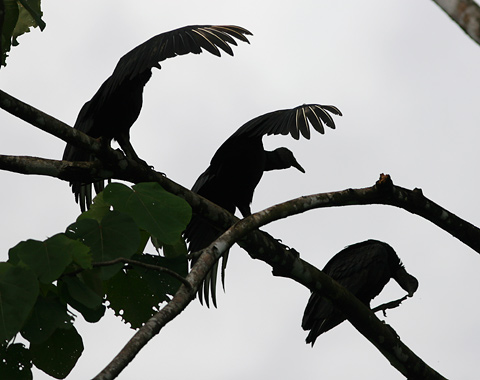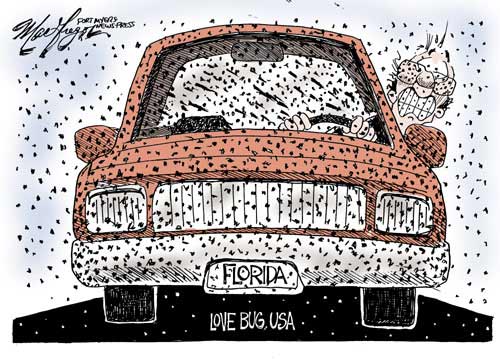
Posted on 04/06/2010 1:20:50 AM PDT by nickcarraway
At Everglades National Park, managers struggle to control vultures' appetites for the rubber and plastic on visitors' vehicles.
Behind her counter in the gift shop at Anhinga Trail, the first and most popular tourist stop in Everglades National Park, Linda Hyde keeps a secret weapon against forbidding creatures that spent much of the winter lurking in the parking lot and preying on random visitors and staffers.
Not pythons, gators, panthers or even infamously blood-thirsty mosquitoes.
Vultures.
Some of the big black birds, known primarily for dining on the dead and decaying, also have developed an appetite for something unusual: car parts.
Windshield wipers, door seals and -- especially scrumptious -- sunroof seals. Anything rubber, but vinyl will do, too.
The birds, mostly black vultures native to much of the Southeast, have trashed visitor and staff cars and trucks and the occasional boat at Flamingo, an outpost on Florida Bay. The park has received seven complaints and one lawsuit seeking $700 to cover repairs, but most damage goes unreported. The problem isn't unique. Vultures across the country have munched on cars, roof shingles, pool screens and an array of stuff for reasons that biologists admit remains a mystery. The park has tried several anti-vulture schemes, yelling at birds, even dangling dead ones upside down -- a scare-vulture that has worked well in many spots.
In the Everglades, the effigy results were mixed. ``The first few days they had it up there, oooh, it was eerie around here,'' recalled Hyde, who lost a windshield seal on her Ford Explorer to vultures. ``The birds and crows were flying around them like crazy.''
The macabre sight in a national park also was difficult to explain, particularly to kiddie visitors. And the carcasses, supplied by a federal nuisance wildlife team that collects dead birds from road kill and rehab centers, grew gamey and required periodic replacement.
With the seasonal vulture populations dwindling, the park took the effigies down last week.
But they could return next winter, along with other anti-vulture measures.
Dave Hallac, chief of biological resources, said the park intends to call in experts from the U.S. Department of Agriculture's National Wildlife Research Center in Gainesville.
``This puts us in kind of a tough situation. These birds are native and they're protected,'' said Hallac. ``We're looking for ways, without injuring the birds, because that's not what we do here, to keep them from damaging vehicles.''
Vultures are common in the park and their ranks swell as turkey vultures move south for the winter, joining resident black vultures.
The behavior has been sporadically seen over the years in Flamingo, 40 miles from the park's entrance, where vultures often gather in trees around a fish-cleaning station and dumpsters near a boat ramp. But numbers swelled in the past few years at the Anhinga boardwalk, a popular stop only a few miles into the park.
Scientists can only speculate on the birds' urges, said Michael Avery, a USDA Wildlife Services biologist and one of the nation's top vulture management experts.
Some park workers believe the rubber releases an aroma, possibly from fish oil, that lures the birds. Avery said experiments with various emissions from chemicals used to make the rubber have provided no clear answers.
``It's still an open question, but I'm kind of leaning against that,'' he said.
Black vultures don't have a great sense of smell and birds don't seem to eat the stuff, Avery said. They just rip it out, ingesting very little.
Another theory Avery prefers, though he calls it ``not very satisfactory,'' is that the birds are using down time to sample available fare. Black vultures, the most common culprits, hunt live prey as well as carrion and car snacking tends to occur in the morning when birds are hanging out together, waiting to warm up and take to the air to forage.
``It's like they are trying stuff,'' he said. ``It may be more prevalent in younger birds as they are learning to grasp things.''
So, like many vandals, they could simply be a gang of bored juveniles.
The problem has increased in several states, likely a result of an expanding vulture population. Still, few visitors come prepared.
Joe and Mary Ann MacDonald, wildlife photographers from Pennsylvania who had led park tours over the years, caught some in the act during a December visit. A staffer tried to chase the birds away but they simply hopped from car to car, he said. MacDonald pulled pillow cases out of his luggage to wrap his windshield wipers, then snapped a shot of a vulture stripping wipers off another car, which he posted with a warning on the Internet.
``I really felt like I was getting sucker punched. This is not an inherent risk you're expecting in a national park,'' he said. ``There were no warnings whatsoever.'' The park has since remedied that. There are now numerous signs -- at the park entrance, at Anhinga Trail and elsewhere -- and warnings on the park website. Hallac said the park may rent tarps next year for visitors to cover cars. Some Flamingo fishing guides routinely use them, he said. Other options include squirt guns or other devices to rattle birds.
The effigies, either dead or artificial, also could make a return next winter. Avery, author of a 2004 study on vulture populations, said the approach has been effective everywhere it's been used. It's not because vultures have no taste for their own, either. Avery believes the sight of a bird dangling upside down is startling, a signal of potential danger: ``If those dead birds were on the ground, we think it would be totally innocuous to them.'' Hyde, the Anhinga Trail shop clerk, is skeptical of effigies and tarps. Vultures ate a hole in a co-worker's tarp, she said. At the gift shop, she keeps a stash of what she believes is the most effective deterrent, which she hands out to co-workers when they stop by: simple plastic bags.
She ties them around windshield wipers and shuts them in doors, where they flutter noisily in the breeze -- which the vultures, at least so far, don't like. ``I've got the rangers using these now,'' she said.
Do you have a recipe for muffler?
Protected or not a shotgun will solve this minor problem.
The park has tried several anti-vulture schemes....
And the carcasses, supplied by a federal nuisance wildlife team....
the park intends to call in experts from the U.S. Department of Agriculture’s National Wildlife Research Center....
....said Michael Avery, a USDA Wildlife Services biologist and one of the nation’s top vulture management experts.
- - -
Kind of sad that it takes this many layers of bureaucracy to deal with property-destroying pests.



“My leetle-a keeller!”
“Black vultures”
So Jesse and Al have a taste for window seals, eh?
In Kings Canyon National Park, it’s the marmots attacking the cars. But I can’t remember whether it’s the rubber they’re after or the anti-freeze.
Rubber has a strong smell, and a chewyness, like meat, so I can see why the animals might be drawn to it.
The kids and I were just watching that old Bugs Bunny Cartoon yesterday. We love old cartoons.

A recipe for eating...why is that kitten pointing a lightning bolt at me?

Carrion eaters have a very important part in nature. But I’m wondering why these birds have over bred and are eating potentially poisonous non-food plastics and causing a nuisance?
Sniffff... I smell a bureaucrat somewhere.
Hey, that’s Candace Bergen’s brother!


Here our our vultures in the park, Warriors Path State Park. They are Turkey vultures.
In recent years they congregate in out trees or in the park nearby. There are hundreds of them when it is cold up north. You can tell when it is going to be bad weather because they suddenly show up. We are the southern most point in their migratory path. There are always 50 or so, but tons when the weather is bad
Disclaimer: Opinions posted on Free Republic are those of the individual posters and do not necessarily represent the opinion of Free Republic or its management. All materials posted herein are protected by copyright law and the exemption for fair use of copyrighted works.